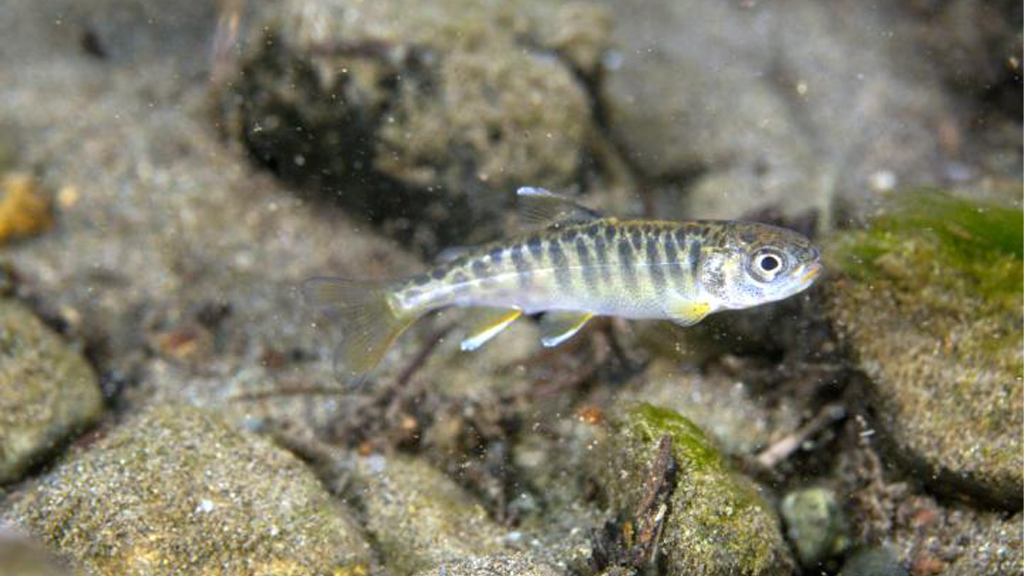The Colville Tribes and the Tribes’ project partners, the Spokane Tribe and the Coeur d’Alene Tribe, have been reintroducing Chinook salmon to the waters upstream of Grand Coulee Dam since 2017. On July 8th, a juvenile Chinook salmon was caught and photographed in the Kettle River, just downstream from Cascade Falls in British Columbia. It’s the first report of a Chinook in the Kettle River since the reintroduction began.
In recent years, the hatchery program has grown to produce approximately 165,000 juvenile hatchery Chinook per year, with about 25,000 released at Kettle Falls in the fall and 60,000 released from the Sherman Creek net pens in the spring. Most released fish swim to the ocean shortly after release, but some stay and rear in the reservoirs and streams for an extra year. Some will stay in freshwater until they are ready to spawn, which can take 2-4 years.
Over the past several years, reports have been received of juvenile Chinook being caught by anglers in the transboundary Columbia River, even upstream of Keenleyside Dam, which means they moved through the boat lock.
The reintroduction effort includes releasing juvenile hatchery fish and also transporting and releasing adult Chinook, which can spawn naturally and produce wild offspring.
The juvenile hatchery fish are tagged with a coded wire ring in the snout and a PIT (passive integrated responder) tag in the abdomen. The adipose fin is not clipped, so it is not possible to tell if a fish is hatchery or wild just by looking at them.
The only way to know if a fish such as the Chinook caught near Cascade Falls was a hatchery release or the wild offspring of an adult transplant is for a biologist to inspect the fish for tags, which has not been done with this Chinook.
Any angler who legally catches a Chinook in Canada is encouraged to report the catch information to the attention of Herb Alex at the office of the Sinixt Confederacy and the Colville Tribes in Nelson, British Columbia, 202-514 Vernon Street, telephone (509) 419- 9801. Chinook sightings in the United States can be reported to the Fish and Wildlife Department of the Colville Tribes in Nespelem, WA at (509) 634-2110. Reports of salmon spawning are helpful as well.
“It is very exciting to see that our fish are colonizing areas beyond where we stock them. This moves us closer to the day when salmon are fully restored to the rivers they swam in time immemorial, on both sides of the Canadian/American border,” said Jarred-Michael Erickson, Chairman of the Colville Confederated Tribes.
“We appreciate the efforts of Colville’s Fish and Wildlife Department on both sides of the border to responsibly and professionally manage these salmon and all natural resources. We also appreciate the generous support of our project partners. The Spokane Tribe and the Coeur d’Alene Tribe have worked closely with us, and the support of the State of Washington and multiple branches of the United States government has also been very valuable,” he said.
About the Colville Tribes: Today, more than 9,151 descendants of 12 aboriginal tribes of Indians are enrolled in the Confederated Tribes of the Colville. The twelve tribes which compose the Confederated Tribes of the Colville Reservation include: ščəlá̕ mxəxʷ (deep water) or Chelan; walw̕ áma (Wallowa people) or Chief Joseph Band of Nez Perce; sx̌ʷyʔiɬp (sharp pointed trees) or Colville; šnt̕iyátkʷəxʷ (grass in the water) or Entiat; snʕáyckst (speckled fish) or Lakes; mətxʷu (blunt hills around a valley) or Methow; škwáxčənəxʷ (people living on the bank) or Moses-Columbia; nspilm (prairie) or Nespelem; uknaqin (seeing over the top) or Okanogan; palúšpam (people from Palouse) or Palus; sənpʕʷilx (grey mist as far as one can see) or San Poil, and šnp̓ əšqʷáw̓ səxʷ (people in between) or Wenatchi.

